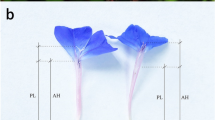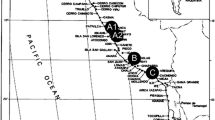Summary
Pontederia cordata L. (Pontederiaceae), a perennial diploid, possesses the rare genetic polymorphism tristyly. A controlled pollination programme was conducted over a three year period, under glasshouse conditions, on 36 clones of P. cordata var. cordata to examine the nature of the self-incompatibility system. The three major findings of the pollination study were: (1) the three floral morphs display different levels of self-incompatibility, (2) pollen from the two anther levels within a flower exhibits different compatibility behaviour in self-pollinations, (3) considerable individual genetic variation in the expression of self-incompatibility is evident among clones within floral morphs. Similar results were also obtained from a smaller study on 15 clones of P. cordata var. lancifolia conducted over a 6 month period. In common with other Pontederia species the mid-styled morph (M) of P. cordata produces large amounts of seed when self-pollinated with pollen from long-level anthers. A developmental model is proposed to explain the high level of self-compatibility of the M morph in Pontederia species. Self-pollination of segregating progenies from M and S morphs of known incompatibility status demonstrated that the expression of incompatibility is closely associated with style length. It is suggested that overall differences in incompatibility behaviour among the floral morphs may be due to the pleiotropic effects of major genes controlling sub-characters of the tristylous syndrome, rather than linked modifier genes. However, the variable expression of trimorphic incompatibility within floral morphs suggests that this variation may be polygenic in origin.
Similar content being viewed by others
References
Baker HG (1966) The evolution, functioning and breakdown of heteromorphic incompatibility systems. 1. The Plumbaginaceae. Evolution 20:349–368
Barrett SCH (1977a) The breeding system of Pontederia rotundifolia L., a tristylous species. New Phytol 78:209–220
Barrett SCH (1977b) Tristyly in Eichhornia crassipes (Mart.) Solms (water hyacinth). Biotropica 9:230–238
Barrett SCH (1978) The floral biology of Eichhornia azurea (Swartz) Kunth (Pontederiaceae). Aquat Bot 5:217–228
Barrett SCH (1979) The evolutionary breakdown of tristyly in Eichhornia crassipes (Mart.) Solms. (water hyacinth). Evolution 33:499–510
Barrett SCH, Price SD, Shore JS (1983) Male fertility and anisoplethic population structure in tristylous Pontederia cordata (Pontederiaceae). Evolution 37:745–759
Barrett SCH (1985a) Floral trimorphism and monomorphism in continental and island populations of Eichhornia paniculata (Spreng.) Solms. (Pontederiaceae). Biol J Linn Soc (in press)
Barrett SCH (1985b) Ecological genetics of breakdown in tristyly. In: Haeck J, Woldendorp JW (eds) Structure and functioning of plant populations. 2. Phenotypic and genotypic variation in plant populations. North-Holland Publishing Company, Amsterdam (in press)
Barrett SCH, Forno IW (1982) Style morph distribution in New World populations of Eichhornia crassipes (Mart.) Solms-Laubach (Water Hyacinth). Aquat Bot 13:299–306
Darwin C (1877) The different forms of flowers on plants of the same species. John Murray, London
Dulberger R (1970) Tristyly in Lythrum junceum. New Phytol 69:751–759
Glover DE, Barrett SCH (1983) Trimorphic incompatibility in Mexican populations of Pontederia sagittata Presl. (Pontederiaceae). New Phytol 95:439–455
Ornduff R (1966) The breeding system of Pontederia cordata L. Bull Torrey Bot Club 93:407–416
Ornduff R (1972) The breakdown of trimorphic incompatibility in Oxalis section Corniculatae. Evolution 26:52–56
Price SD, Barrett SCH (1982) Tristyly in Pontederia cordata (Pontederiaceae). Can J Bot 60:897–905
Price SD, Barrett SCH (1984) The function and adaptive significance of tristyly in Pontederia cordata L. (Pontederiaceae). Biol J Linn Soc 21:315–329
Richards JH, Barrett SCH (1984) The development basis of tristyly in Eichhornia paniculata. Am J Bot 71:1347–1363
Stout AB (1923) Studies of Lythrum salicaria. 1. The efficiency of self-pollination. Am J Bot 10:440–449
Weller SG (1980) The incompatibility relationships of tristylous species of Oxalis section Ionoxalis of southern Mexico. Can J Bot 58:1908–1911
Author information
Authors and Affiliations
Additional information
Communicated by H. F. Linskens
Rights and permissions
About this article
Cite this article
Barrett, S.C.H., Anderson, J.M. Variation in expression of trimorphic incompatibility in Pontederia cordata L. (Pontederiaceae). Theoret. Appl. Genetics 70, 355–362 (1985). https://doi.org/10.1007/BF00273739
Received:
Accepted:
Issue Date:
DOI: https://doi.org/10.1007/BF00273739




